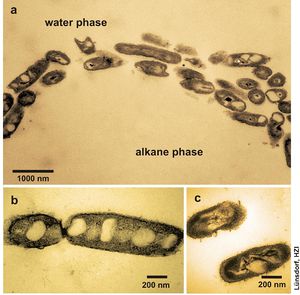Alcanivorax

Classification
Bacteria; Phylum: Proteobacteria; Class: Gammaproteobacteria; Order: Oceanospirillales; Family: Alcanivoracaceae
Species
|
NCBI: Taxonomy |
- Alcanivorax balearicum
- Alcanivorax borkumensis
- Alcanivorax dieselolei
- Alcanivorax indicus
- Alcanivorax jadensis
- Alcanivorax venustensis
Description and Significance

Alcanivorax, first described in 1998, is a Gram-negative, aerobic, rod-shaped, oil-degrading marine bacterium that is found in low abundances in unpolluted environments in the upper layers of the ocean, but quickly becomes the predominant microbes in oil-contaminated open oceans and coastal waters when nitrogen and phosphorus are not limiting. When conditions in these moderately halophilic environments are right, Alcanivorax may make up 80-90% of the oil-degrading microbial community. As a result of their profound ability to degrade and live predominately on alkanes, as well as to become the dominant microbes in oil-contaminated areas, Alcanivorax plays a huge role in the biological cleanup of oil-contaminated environments. These oil-contaminated environments in the ocean are largely due to anthropogenic sources such as oil spills caused by tankers accidents, and cause serious ecological damage to coastal fauna and flora as well as other inhabitants of the ocean. Microbes such as Alcanivorax provide a major route for the breakdown of these pollutants, and demonstrate how marine bacteria keep the environment in check. Of all the Alcanivorax species and other oil-degrading microbes, Alcanivorax borkumensis is one of the most important worldwide due to the fact it produces a wide variety of very efficient oil-degrading enzymes. With this knowledge, Alcanivorax borkumensis could provide a useful tool for bioremediation of oil spills.
Genome Structure

The Alcanivorax borkumensis strain SK2 was the first hydrocarbonoclastic bacterium to be sequenced and was completed by Susanne Schneiker et al. It's genome consists of a single circular chromosome with 3,120,143 base pairs with an average G+C content of 54.7%. The genomic analysis of A. borkumensis SK2 revealed several new insights into the bacterium's role for (i) n-alkane degradation (which includes metabolism, biosurfactant production and biofilm production), (ii) it's system for capturing or scavenging the small amounts of nitrogen, phosphorous, sulfur, and other elements in a nutrient-poor marine environment which allows for more efficient alkane degradation due to their main limitation of nutrient availability, (iii) as well as means for coping with stress factors such as high salt contents and high UV radiation since it thrives mostly in the upper layers in the ocean where UV light is encountered. It's genome encodes several systems for the catabolism of hydrocarbons which allow the bacertium to degrade all sorts of alkanes such as AlkB1 alkane hydroxylase which oxidizes medium-chain alkanes in the range of C5-C12, and AlkB2 alkane hydroxylase which oxidizes medium-chain alkanes in the range of C8 to C16. Both these systems are located close to the origin of replication of the chromosome. A. borkumensis is also able to degrade alkanes up to C32, branched aliphatic hydrocarbons, isoprenoid hydrocarbons such as phytane, as well as alkylarenes and alkylcycloalkanes. Thus, the genome encodes for a broad spectrum of systems for the catabolism of hydrocarbons, giving it a competitive advantage over other oil-degrading marine microbial communities. To deal with the damaging effects of UV light, A. borkumensis has a number of genes that reduce the damage. These include the full genes for DNA alkylation, recombinational and nucleotide excision repair, base excision repair, as well as the SOS response (Schneiker et al. 2006).
Cell Structure, Metabolism and Life Cycle
Interesting features of cell structure; how it gains energy; what important molecules it produces.
Ecology and Pathogenesis
Habitat; symbiosis; biogeochemical significance; contributions to environment.
If relevant, how does this organism cause disease? Human, animal, plant hosts? Virulence factors, as well as patient symptoms.
References
[3] Lorenzo, Víctor De. "Blueprint of an Oil-eating Bacterium." Nature Biotechnology 24 (2006): 952-953.
Author
Page authored by Andrew Buss, student of Prof. Jay Lennon at Michigan State University.
